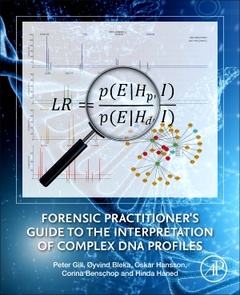Forensic Practitioner's Guide to the Interpretation of Complex DNA Profiles
Auteurs : Gill Peter, Bleka Øyvind, Hansson Oskar, Benschop Corina, Haned Hinda

Over the past twenty years, there?s been a gradual shift in the way forensic scientists approach the evaluation of DNA profiling evidence that is taken to court. Many laboratories are now adopting ?probabilistic genotyping? to interpret complex DNA mixtures. However, current practice is very diverse, where a whole range of technologies are used to interpret DNA profiles and the software approaches advocated are commonly used throughout the world.
Forensic Practitioner?s Guide to the Interpretation of Complex DNA Profiles places the main concepts of DNA profiling into context and fills a niche that is unoccupied in current literature. The book begins with an introduction to basic forensic genetics, covering a brief historical description of the development and harmonization of STR markers and national DNA databases. The laws of statistics are described, along with the likelihood ratio based on Hardy-Weinberg equilibrium and alternative models considering sub-structuring and relatedness. The historical development of low template mixture analysis, theory and practice, is also described, so the reader has a full understanding of rationale and progression. Evaluation of evidence and statement writing is described in detail, along with common pitfalls and their avoidance.
The authors have been at the forefront of the revolution, having made substantial contributions to theory and practice over the past two decades. All methods described are open-source and freely available, supported by sets of test-data and links to web-sites with further information. This book is written primarily for the biologist with little or no statistical training. However, sufficient information will also be provided for the experienced statistician. Consequently, the book appeals to a diverse audience
1. Forensic genetics: the basics2. Empirical characterization of DNA profiles3. Allele drop-out and the stochastic threshold4. Low-template DNA5. LRmix model theory6. A qualitative (semi-continuous)model: LRmix Studio7. The quantitative (continuous)model theory8. EuroForMix9. Validation10. Development and implementation of DNAxs11. Investigative forensic genetics: SmartRank, CaseSolver and DNAmatch212. Interpretation, reporting, and communication13. Interpretation of complex DNA profiles generated by massively parallel sequencing
A. Formal descriptions of the genotype probabilitiesB. Formal description of the probabilisticmodels
The book is primarily aimed at the practitioner: scientists who are dealing with case-work on a routine basis, and usually have not had formal statistical training. Because the book will assume little prior knowledge it will also be useful for University courses in forensic science. Specialist lawyers will find the book useful. It provides advice for court-reporting, including limitations of methods. Advanced users e.g. statisticians with little knowledge of forensics or the biological aspects will find the book useful. Mixture analysis is of interest in the medical genetics field and wildlife genetics.
Romanovs
In 1993-4, Dr. Gill was responsible for leading the team which confirmed the identity of the remains of the Romanov family, murdered in 1918, and also the subsequent investigation which disproved the claim of Anna Anderson to be the Duchess Anastasia (using tissue preserved in a paraffin wax block for several decades). This was an early example of an historical mystery that was solved by the analysis of very degraded and aged material, and was one of the first demonstrations of low-template DNA analysis.
Low-template DNA
In relation to the above, Dr. Gill was responsible for developing a routine casework-based ‘super-sensitive’ method of DNA profiling that was capable of analysing DNA profiles from a handful of cells. This method was originally known as low-copy-number (LCN) DNA profiling. Now it is known as Low template DNA profiling. New statistical methods and thinking were also developed to facilitate the new methods.
National DNA database
Dr. Gill was responsible for leading the team that developed the first multiplex DNA systems to be used in a National DNA database anywhere in the world, and for the design of interpretation methods that are in current use (c.1995).
Court reporting: Dr. Gill has been involved with giving evidence in
- Covers short tandem repeat (STR) analysis, including database searching and massive parallel sequencing (both STRs and SNPs)
- Encourages dissemination and understanding of probabilistic genotyping by including practical examples of varying complexity
- Written by authors intimately involved with software development, training at international workshops and reporting cases worldwide using the methods described in this book
Date de parution : 06-2020
Ouvrage de 530 p.
19x23.3 cm
Thème de Forensic Practitioner's Guide to the Interpretation of... :
Mots-clés :
Forensic Genetics; DNA Profiles; DNA Interpretation; Genotyping; STRs; SNPs; DNA Databases; DNA Evidence



